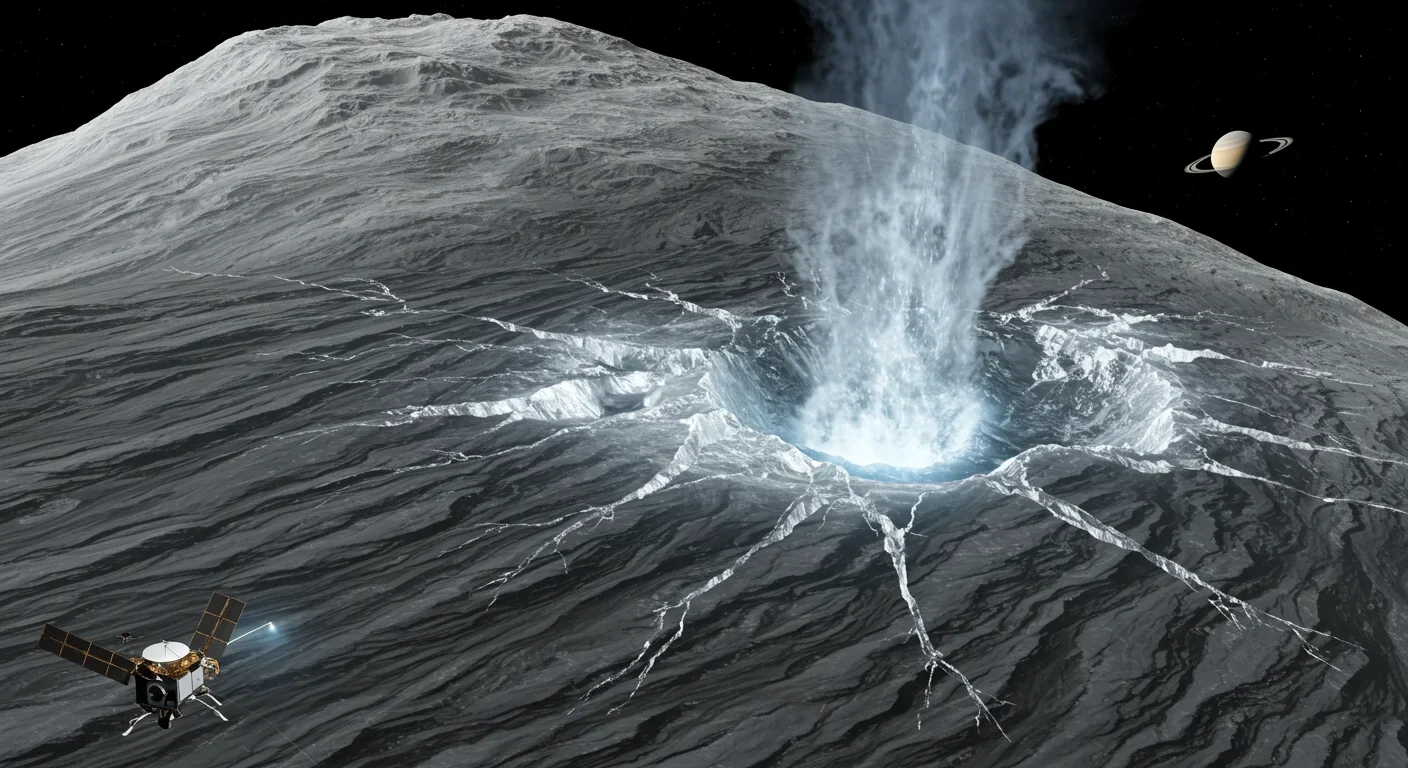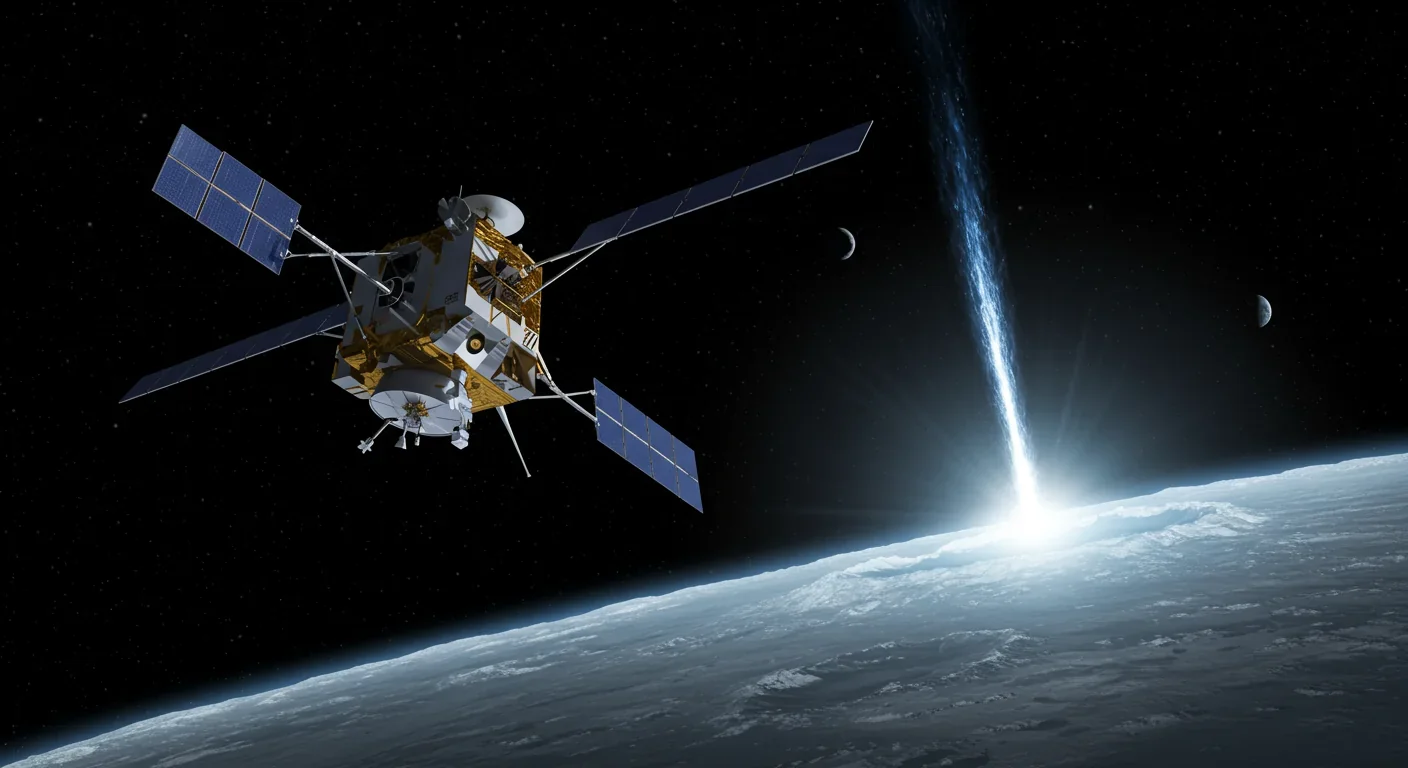Fusion Rockets Could Reach 10% Light Speed: The Breakthrough

TL;DR: Cassini spacecraft discovered that Enceladus, Saturn's icy moon, erupts water plumes containing molecular hydrogen, complex organic molecules, and chemical signatures identical to Earth's deep-sea hydrothermal vents—suggesting a subsurface ocean that could harbor life. If confirmed by future missions launching in the 2030s, Enceladus would prove life can emerge anywhere water touches rock, transforming our understanding of habitability and making the search for extraterrestrial biology a practical reality within our lifetime.

By 2030, scientists predict that spacecraft designed to sniff the plumes of Enceladus, Saturn's sixth-largest moon, could return definitive evidence of extraterrestrial life—not from distant exoplanets or Mars, but from a tiny, icy world shooting its ocean into space. If the findings hold, humanity's first contact with alien biology might come not from radio signals but from water droplets frozen in Saturn's rings.
In October 2015, the Cassini spacecraft dove through geysers erupting from Enceladus's south pole at 19,000 miles per hour. Its Ion and Neutral Mass Spectrometer tasted something extraordinary: a plume composed of 98% water vapor, 1% molecular hydrogen, and trace amounts of methane, carbon dioxide, and ammonia—the exact chemical signature of hydrothermal vents on Earth's ocean floor.
But the real surprise came later. In 2018, reanalysis of 2008 flyby data revealed complex organic molecules with masses exceeding 200 atomic mass units—more than ten times heavier than methane. These weren't simple compounds weathered by space radiation. They were fresh, nitrogen- and oxygen-bearing molecules ejected only minutes before Cassini caught them, including aromatic rings, ethers, esters, and heterocycles identical to those synthesized in Earth's deep-sea vent systems.
"We now have proof that there are prebiotic complex molecules in the ocean of Enceladus," said Dr. Jörn Helbert of the German Aerospace Center. The discovery represented a paradigm shift: for the first time, scientists had direct chemical evidence that an alien ocean might be brewing the building blocks of life.
What makes Enceladus extraordinary isn't just that it has water—it's that the moon is serving up samples of its subsurface ocean on a silver platter. Every second, 250 kilograms of ocean material erupts through tiger-stripe fractures at the south pole, creating Saturn's gossamer E-ring. No drilling required. No landers needed. The ocean comes to you.
Before 2005, Enceladus was an afterthought—a small, frozen moon reflecting almost 100% of sunlight, making it one of the brightest objects in the solar system. Planetary scientists expected a geologically dead world, perhaps pockmarked with ancient craters. Then Cassini's magnetometer detected something impossible: a disturbance in Saturn's magnetic field near Enceladus, suggesting the moon was spewing charged particles into space.
Images confirmed the impossible. Towering plumes of water vapor rose hundreds of miles above the surface, backlit by the sun. Cassini had discovered active cryovolcanism—ice volcanoes powered by an internal ocean on a moon that should have been frozen solid.
The parallels to Earth's own history are striking. Four billion years ago, our planet's oceans were lifeless chemical soups. Then, in the lightless depths near mid-ocean ridges, superheated water began percolating through cracks in the seafloor, dissolving minerals and creating chemical gradients. These hydrothermal vents—discovered only in 1977—turned out to be oases of life, supporting ecosystems entirely independent of sunlight. Tube worms, eyeless shrimp, and microbial mats thrived on chemical energy alone.
Many scientists now believe life on Earth may have begun at such vents. The presence of molecular hydrogen—a potent source of chemical energy—combined with carbon dioxide and minerals creates conditions where simple organic molecules can assemble into more complex forms. Microbes called methanogens harvest hydrogen to reduce CO₂ into methane, extracting energy in the process. It's a metabolism that doesn't need oxygen, sunlight, or organic matter from the surface. It needs only water, rock, and heat.
Enceladus has all three.
How do you study an ocean buried beneath 20 kilometers of ice without landing on the surface? Cassini demonstrated the answer: fly through the plumes and analyze what comes out.
The spacecraft's Cosmic Dust Analyzer (CDA) was essentially a sophisticated particle detector. As ice grains struck the instrument at 18 kilometers per second, the kinetic energy vaporized them instantly. The ionized fragments produced unique mass spectra—chemical fingerprints revealing the molecules locked inside.

Lower-speed impacts had previously captured only simple molecules like water, methane, and ammonia. But the 2008 E5 flyby, conducted at extreme velocity, shattered ice grains with such force that it liberated complex organics normally hidden by water clustering. Suddenly, scientists could see aromatic hydrocarbons, nitrogen-bearing heterocycles, and oxygen-rich esters—the same compounds found in terrestrial hydrothermal fluids.
Meanwhile, the Ion and Neutral Mass Spectrometer (INMS) measured gases in the plume. The detection of molecular hydrogen was the smoking gun. On Earth, H₂ forms when seawater circulates through hot, iron-rich rocks in a process called serpentinization. Water molecules split, combining with metals to form hydroxides and releasing hydrogen gas. The hydrogen then becomes fuel for chemosynthetic life.
Finding 1% hydrogen in Enceladus's plume meant the same process was happening there—right now. The moon's ocean was in active contact with a rocky core, heated to at least 90°C, dissolving silicates and releasing energy-rich hydrogen. It was a chemical factory identical to Earth's Lost City hydrothermal field, where pH reaches 11 and life thrives without sunlight.
The confirmation of life on Enceladus would mark the most profound shift in human self-understanding since Copernicus displaced Earth from the center of the cosmos. For millennia, religions, philosophies, and sciences have grappled with humanity's uniqueness. Are we alone? Are we special? Does life require a perfect Goldilocks planet, or can it emerge wherever water touches rock?
Enceladus suggests the latter. And if life can arise independently in our solar system—twice—the implications cascade outward. The Milky Way contains an estimated 40 billion Earth-sized planets in habitable zones. But Enceladus isn't in a habitable zone. It's 886 million miles from the Sun, receiving 1% of Earth's sunlight. It survives on tidal heating—gravitational flexing from Saturn's pull. Yet it may host life.
If tidal heating alone suffices, the number of habitable worlds explodes. Every planet with moons, every moon with a liquid core, every subsurface ocean becomes a candidate. Europa, Titan, Ganymede, Callisto, Triton—suddenly, the solar system is teeming with potential biospheres.
"If we find life anywhere else in the solar system," says Dr. Caroline Freissinet of NASA's Goddard Space Flight Center, "it means that it's not random, it means it's everywhere in the galaxy."
This would reshape industries, too. The commercial space sector—already valued at $469 billion—would pivot toward astrobiology. Companies like SpaceX and Blue Origin, currently focused on Mars, might redirect missions to the outer solar system. Sample-return missions could become lucrative if Enceladus water contains biosignatures valuable to pharmaceutical research or synthetic biology.
Education systems would overhaul curricula. Astrobiology would shift from niche elective to core science. Questions like "What is life?" and "How do we recognize it?" would dominate biology courses. Public interest in STEM could surge as the search for life becomes tangible, not theoretical.
Philosophically, religions would face their Galileo moment. Some traditions already accommodate extraterrestrial life; others would require theological reinterpretation. If microbes on Enceladus share biochemistry with Earth—same amino acids, same chirality—panspermia (life spreading between worlds) becomes plausible, linking all life in the solar system to a single origin. If Enceladus life is biochemically alien—different amino acids, different genetic code—it proves life can start independently, making the universe a garden of diverse biologies.
The scientific payoff from Enceladus missions would be staggering. A dedicated orbiter and lander—the Enceladus Orbilander, ranked second-highest priority in NASA's 2023-2032 Decadal Survey—would conduct twelve plume flybys, analyzing fresh ocean material with mass spectrometers 1,000 times more sensitive than Cassini's. Then it would land on the south pole, where ice is only 1-5 kilometers thick, drilling into refrozen plume deposits to analyze isotopic ratios, search for cellular structures, and detect metabolic byproducts.
Europe's ESA is planning a complementary mission in the 2040s, potentially using Enceladus as a testbed for life-detection instruments bound for Europa or Titan. These missions could answer:
Do amino acids on Enceladus exhibit homochirality? On Earth, life uses only left-handed amino acids and right-handed sugars. Finding the same bias on Enceladus would hint at shared origin; finding the opposite would prove independent genesis.
Are there isotopic biosignatures? Biological processes prefer lighter isotopes. Carbon-12 over Carbon-13, Hydrogen over Deuterium. Measuring isotope ratios in Enceladus organics could distinguish biotic from abiotic chemistry.
Does the ocean contain adenosine triphosphate (ATP) or analogues? ATP is life's universal energy currency. Detecting it—or a functional equivalent—would be direct evidence of metabolism.
Beyond astrobiology, Enceladus is a laboratory for planetary science. Understanding tidal heating informs models of exomoon habitability around gas giants in other star systems. Measuring ocean salinity, pH, and mineral content refines our knowledge of water-rock interactions in low-temperature environments. Studying plume dynamics teaches us how subsurface oceans vent into space, applicable to Europa, Triton, and even ancient Mars.
Technologically, missions to Enceladus drive innovation. Engineers at JPL have designed low-mass, high-efficiency instruments using Distributed Power Architecture, reducing mission costs by $900 million while maintaining flagship-class science. Advances in cold-gas thrusters, radioisotope power systems, and autonomous sampling will cascade into Earth applications—deep-sea robotics, polar research, hazardous-environment monitoring.
But what if we go to Enceladus and find nothing? What if the ocean is sterile—rich in chemistry but barren of life?

Such a null result would be scientifically valuable but philosophically destabilizing. It would suggest habitability doesn't guarantee life, that the leap from chemistry to biology requires rare, poorly understood conditions. It might mean Earth's biosphere is an accident, a statistical outlier in a mostly lifeless cosmos.
Or worse: we might contaminate Enceladus before we can study it. Despite strict planetary protection protocols, spacecraft carry microbial hitchhikers. Cassini deliberately plunged into Saturn in 2017 to avoid contaminating Enceladus or Titan. Future landers face the same dilemma. Even if sterilized to NASA standards, Earth microbes could theoretically survive dormant in spacecraft crevices, waking in Enceladus's ocean. If Earth life takes root there, future scientists might mistake terrestrial contamination for native biology—an irreversible scientific catastrophe.
There's also the equity problem. Space missions are expensive. The Enceladus Orbilander is projected at $4.9 billion. That money could fund schools, hospitals, climate adaptation. Critics argue that searching for microbes on an icy moon while Earth faces existential crises is a misallocation of resources. Proponents counter that astrobiology advances technology, inspires education, and diversifies humanity's long-term survival prospects. The debate mirrors historical arguments over Apollo, the Human Genome Project, and CERN—investments whose value became clear only in hindsight.
Finally, there's the challenge of interpretation. Life detection is hard. We have no universally accepted definition of life, no foolproof biosignature. Amino acids can form abiotically. Isotopic fractionation can result from thermodynamic processes. Even detecting cells wouldn't be conclusive—mineral structures can mimic biology. The 1996 Mars meteorite ALH84001, once claimed to contain Martian microfossils, remains controversial decades later. Enceladus findings could spark similar disputes, with consensus emerging only after exhaustive peer review—or never.
Space exploration has always been geopolitical. The Space Race was Cold War theater. Today, NASA collaborates with ESA, JAXA, and CSA, but China and India are rising players with independent lunar and Mars programs. Enceladus is far enough away—and expensive enough—that international cooperation is pragmatic. No single nation can afford a flagship mission alone.
The Cassini mission exemplified this. NASA provided the orbiter, ESA provided the Huygens Titan lander, and Italy's ASI contributed radar and antennas. Data were shared globally, published in open-access journals, analyzed by scientists from dozens of countries. An Enceladus mission would likely follow this model, with shared costs, shared risks, and shared glory.
But equity concerns persist. Developing nations contribute little to space science budgets yet share the same curiosity. Should astrobiology data be freely available? Should life-detection technologies be open-source? The Outer Space Treaty (1967) declares celestial bodies the "province of all mankind," but enforcement is murky. If a corporation patents Enceladus biosignatures for pharmaceutical use, who benefits—humanity or shareholders?
Cultural perspectives vary, too. Western science tends toward mechanistic explanations, viewing life as chemistry. Indigenous cosmologies often emphasize interconnectedness, seeing life as relationship rather than mechanism. If Enceladus harbors life, how we describe it—"microbe," "organism," "entity"—will shape public understanding and policy. Inclusive dialogue is essential to avoid repeating colonial patterns where dominant cultures define meaning for everyone.
You don't need a PhD to participate in the search for life. Citizen science projects like Planet Four and Galaxy Zoo have crowdsourced millions of observations. Future Enceladus missions could recruit volunteers to scan images for plume anomalies, classify ice grain spectra, or model ocean circulation.
Educationally, demand astrobiology content. Support STEM programs in schools. Advocate for science funding. Write to representatives about NASA and ESA budgets. Public enthusiasm drives political will—Apollo happened because Americans demanded it.
Professionally, skills in robotics, AI, data science, and materials engineering are critical. The next generation of spacecraft will rely on autonomous navigation, machine learning for biosignature detection, and radiation-hardened electronics. Engineers, programmers, and technicians will be as vital as biologists.
Intellectually, cultivate comfort with uncertainty. The search for life is probabilistic, not guaranteed. Negative results are data. Ambiguity is normal. Science progresses through iterative refinement, not sudden revelation. Patience and rigor matter more than hype.
If funded in the late 2020s, the Enceladus Orbilander could launch in the early 2030s, arriving at Saturn by 2050. A faster alternative—the Enceladus Multiple Flyby mission—could launch sooner, conducting repeated plume passes without landing. Either way, definitive answers are decades away.
But incremental progress continues. The Europa Clipper, launching in 2024, carries next-generation mass spectrometers developed by Cassini veterans. Lessons from Europa will inform Enceladus missions. Similarly, advancements in cryobot drilling (tested in Antarctica) and underwater robotics (refined in Earth's oceans) bring us closer to exploring alien seas.
Meanwhile, laboratory experiments simulate Enceladus conditions. Researchers freeze water mixed with ammonia, silicates, and organics, then bombard samples with ions to replicate space weathering. Others culture extremophiles in high-pH, hydrogen-rich baths mimicking Lost City vents. These experiments constrain what's possible, narrowing the parameter space for life.
Theoretical work advances too. Thermodynamic models calculate the Gibbs free energy of organic synthesis in Enceladus-like oceans, predicting which molecules form spontaneously. Machine learning algorithms train on terrestrial biosignatures, learning to distinguish biological from geological patterns. When Orbilander data arrive, we'll be ready to interpret them.
The geysers of Enceladus are calling. The ocean is waiting. The only question is whether we'll answer—or whether future generations will wonder why we hesitated at the threshold of the greatest discovery in human history. Because somewhere beneath that ice, in the lightless depths of an alien sea, chemistry may have crossed the line into biology. And if it did, everything changes.

Recent breakthroughs in fusion technology—including 351,000-gauss magnetic fields, AI-driven plasma diagnostics, and net energy gain at the National Ignition Facility—are transforming fusion propulsion from science fiction to engineering frontier. Scientists now have a realistic pathway to accelerate spacecraft to 10% of light speed, enabling a 43-year journey to Alpha Centauri. While challenges remain in miniaturization, neutron management, and sustained operation, the physics barriers have ...

Epigenetic clocks measure DNA methylation patterns to calculate biological age, which predicts disease risk up to 30 years before symptoms appear. Landmark studies show that accelerated epigenetic aging forecasts cardiovascular disease, diabetes, and neurodegeneration with remarkable accuracy. Lifestyle interventions—Mediterranean diet, structured exercise, quality sleep, stress management—can measurably reverse biological aging, reducing epigenetic age by 1-2 years within months. Commercial ...

Data centers consumed 415 terawatt-hours of electricity in 2024 and will nearly double that by 2030, driven by AI's insatiable energy appetite. Despite tech giants' renewable pledges, actual emissions are up to 662% higher than reported due to accounting loopholes. A digital pollution tax—similar to Europe's carbon border tariff—could finally force the industry to invest in efficiency technologies like liquid cooling, waste heat recovery, and time-matched renewable power, transforming volunta...

Humans are hardwired to see invisible agents—gods, ghosts, conspiracies—thanks to the Hyperactive Agency Detection Device (HADD), an evolutionary survival mechanism that favored false alarms over fatal misses. This cognitive bias, rooted in brain regions like the temporoparietal junction and medial prefrontal cortex, generates religious beliefs, animistic worldviews, and conspiracy theories across all cultures. Understanding HADD doesn't eliminate belief, but it helps us recognize when our pa...

The bombardier beetle has perfected a chemical defense system that human engineers are still trying to replicate: a two-chamber micro-combustion engine that mixes hydroquinone and hydrogen peroxide to create explosive 100°C sprays at up to 500 pulses per second, aimed with 270-degree precision. This tiny insect's biochemical marvel is inspiring revolutionary technologies in aerospace propulsion, pharmaceutical delivery, and fire suppression. By 2030, beetle-inspired systems could position sat...

The U.S. faces a catastrophic care worker shortage driven by poverty-level wages, overwhelming burnout, and systemic undervaluation. With 99% of nursing homes hiring and 9.7 million openings projected by 2034, the crisis threatens patient safety, family stability, and economic productivity. Evidence-based solutions—wage reforms, streamlined training, technology integration, and policy enforcement—exist and work, but require sustained political will and cultural recognition that caregiving is ...

Every major AI model was trained on copyrighted text scraped without permission, triggering billion-dollar lawsuits and forcing a reckoning between innovation and creator rights. The future depends on finding balance between transformative AI development and fair compensation for the people whose work fuels it.